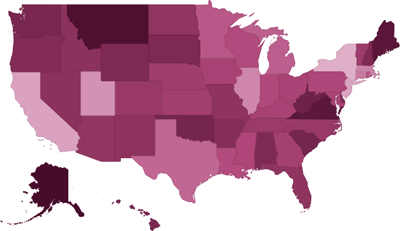According to the United States Department of Veterans Affairs, in 2014 the U.S. Veteran population was estimated as follows (DVA 2016):
- Projected U.S. Veterans population: 21,681,000 (19,646,000 men and 2,035,000 women)
- Projected number of living WW II Veterans (as of 9/30/2015): 847,000
- Estimated number of WW II Veterans pass away per day: 465
- Percentage of Veteran population 65 or older: 45.82%
- Veteran population by race:
- White 82.0%
- Black 12.4%
- Hispanic 6.9%
- Asian/Pacific Islander 1.6%
- American Indian/Alaska Natives 0.8%
- Other 3.2%
A Veteran is any person who has served in the U.S. armed forces, including the National Guard and Reserve. A person need not have served in combat to be a Veteran. Veterans live in all states; the five states with the greatest Veteran populations are California, Florida, Texas, Pennsylvania, and New York.
Veteran Population by Percentage of State Population

The darkest color states have the largest percentage of veterans. Source: DVA/NCVAS 2015. Google.com.
According to America’s Wars Fact Sheet, published May 2017, the number of Veterans on benefits rolls as of April 2017 was:
- Gulf War Veterans—2,160,897
- Vietnam Era Veterans—1,544,274
- Korean Conflict Veterans—172,837
- World War II Veterans—120,240
- Philippines—1,548
- Peacetime—726,238 (DVA, 2017a)
The fastest growing cohort of U.S. Veterans is women. In 2015 women constituted 9.4% (about 2 million) of the total U.S. Veteran population of 21.7 million. By 2023 it is projected that women will make up 16.3% of all living Veterans (DVA/NCVAS, 2017).
Effective triage, trauma treatment, and recover maneuvers during Operation Iraqi Freedom and Operation New Dawn (OIF) in Iraq, and Operation Enduring Freedom (OEF) in Afghanistan, have resulted in extraordinary survival rates. However the number of physically and mentally wounded individuals exceeded 32,000 from OIF and 16,000 from OEF (Allen et al., 2015).
The mission of the U.S. Department of Veterans Affairs is “to fulfill President Lincoln’s promise ‘To care for him who shall have borne the battle, and for his widow, and his orphan’ by serving and honoring the men and women who are America’s Veterans.” This mission is supported by five core values: Integrity, Commitment, Advocacy, Respect, and Excellence, which, taken together form the acronym “I CARE.”
Executive Order 13625, Improving Access to Mental Health Services for Veterans, Service Members, and Military Families, was issued by President Barack Obama on August 31, 2012. It created the Interagency Task Force (ITF) on Military and Veterans Mental Health and tasked it with providing an annual review of agency actions, defining specific goals and metrics to aid in measuring progress, and making additional recommendations to improve mental health and substance use disorder treatment services for U.S. Veterans, service members, and their families.
